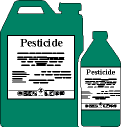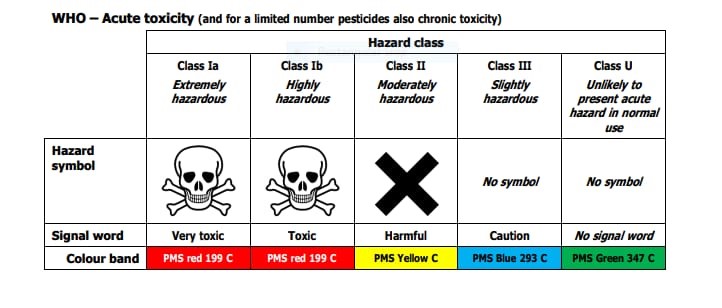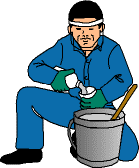
What Does the Label Say?
- Always read the label and follow the instructions
- The colour band and pictograms on the container tell you how to handle, apply and store a pesticide.
- The colour band also contains warnings concerning animals and the environment.
- The colour of the band indicates the hazardous (dangerous) degree to people.
|
|
Red |
very toxic/toxic |
|
|
Yellow |
harmful |
||
|
Blue |
caution |
||
|
Green |
acute hazard unlikely during normal use |

Handling Pesticides
When mixing pesticides
- WEAR: eye protection
- rubber gloves
- rubber boots
When applying pesticides:
- WEAR: mouth protection
- rubber gloves
- rubber boots
Storage Advice
- Keep locked away from children and animals
- Wash after use
- Dangerous/harmful to animals
- Dangerous/harmful to fish—do not contaminate rivers and dams
- DO NOT store food in empty pesticide containers
- DO NOT store pesticides in food containers
- RINSE empty pesticide containers and
- DESTROY them
Appropriate Storage Methods For Various Products
Prevent the risk of agrochemicals and stock remedies being used to poison livestock, people and even to destroy crops. Losses are costly and can be avoided by efficient security.
Product Segregation
Separate herbicides from other agrochemicals.
“Very toxic/Toxic” products should be grouped together.
Flammable products should be interspersed with non-flammable products of their own group.
Understanding The Labelling Of Chemicals
A learner being trained in the specific outcome of safety should have knowledge of the details on a label.
Explain the different classes of insecticides and herbicides and colour coding used on the labels.
Indicate the contact numbers on the labels of the supplier, and the emergency no., as well as the poison information centre.
Explain, EC, GR etc. different formulations – indicates safe use of these chemicals in the workplace for optimum results and to avoid undesired chemical effects.
The learner must take note of the colouration on the labels with the pictograms
- Familiarise yourself with pictograms and labels and danger symbols (crossbones and skull).
- Recognize the different formulations on the label.
- Acknowledge the contact details of the pesticide and herbicide manuals.

Safe Use Of Chemicals (Safety Procedures)
Buy smart, only buy from an accredited dealer or sales person, not from a friend.
Follow the AVCASA manual for transportation, and storage (preferably concrete or brick, with ventilation.) Lock storage room. Do not keep with paraffin or other substances that is needed often. Do not use paraffin containers or cool drink bottles.
Discuss: entering of products to the body. See that you are adequately protected by correct clothing (see above).
Disposal of containers: Puncture and reduce in bulk or size, bury. Don’t burn PVC, but burn cardboard and paper.
Care and storage for chemicals are discussed: Learners are advised on how to care for chemicals, where to store them, where to keep keys for store room and what containers to use. They are advised on label instructions and not to re-use containers or other containers.
Designated Areas
Adequate signage (approved by the authorities) that is easy to observe should be placed in locations designated for a specific purpose. These signs must give a bold, concise message such as:
- Danger.
- No Entry.
- No smoking.
- No drinking and eating.
- Fire-extinguisher location.
- First Aid Equipment location.
- Emergency Exit.
These signs are either informative in nature or give a clear instruction in a manner that is understandable to all irrespective of their language.
Chemicals should only be mixed in areas designated for the purpose, such as at filling points. These areas should be clearly marked and unauthorised personnel should not be allowed into these areas while chemicals are being handled.
